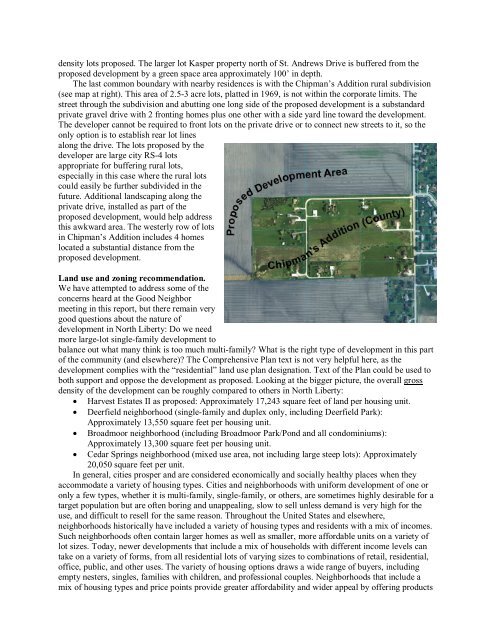Complete April packet - City of North Liberty
Complete April packet - City of North Liberty
Complete April packet - City of North Liberty
You also want an ePaper? Increase the reach of your titles
YUMPU automatically turns print PDFs into web optimized ePapers that Google loves.
density lots proposed. The larger lot Kasper property north <strong>of</strong> St. Andrews Drive is buffered from the<br />
proposed development by a green space area approximately 100’ in depth.<br />
The last common boundary with nearby residences is with the Chipman’s Addition rural subdivision<br />
(see map at right). This area <strong>of</strong> 2.5-3 acre lots, platted in 1969, is not within the corporate limits. The<br />
street through the subdivision and abutting one long side <strong>of</strong> the proposed development is a substandard<br />
private gravel drive with 2 fronting homes plus one other with a side yard line toward the development.<br />
The developer cannot be required to front lots on the private drive or to connect new streets to it, so the<br />
only option is to establish rear lot lines<br />
along the drive. The lots proposed by the<br />
developer are large city RS-4 lots<br />
appropriate for buffering rural lots,<br />
especially in this case where the rural lots<br />
could easily be further subdivided in the<br />
future. Additional landscaping along the<br />
private drive, installed as part <strong>of</strong> the<br />
proposed development, would help address<br />
this awkward area. The westerly row <strong>of</strong> lots<br />
in Chipman’s Addition includes 4 homes<br />
located a substantial distance from the<br />
proposed development.<br />
Land use and zoning recommendation.<br />
We have attempted to address some <strong>of</strong> the<br />
concerns heard at the Good Neighbor<br />
meeting in this report, but there remain very<br />
good questions about the nature <strong>of</strong><br />
development in <strong>North</strong> <strong>Liberty</strong>: Do we need<br />
more large-lot single-family development to<br />
balance out what many think is too much multi-family? What is the right type <strong>of</strong> development in this part<br />
<strong>of</strong> the community (and elsewhere)? The Comprehensive Plan text is not very helpful here, as the<br />
development complies with the “residential” land use plan designation. Text <strong>of</strong> the Plan could be used to<br />
both support and oppose the development as proposed. Looking at the bigger picture, the overall gross<br />
density <strong>of</strong> the development can be roughly compared to others in <strong>North</strong> <strong>Liberty</strong>:<br />
• Harvest Estates II as proposed: Approximately 17,243 square feet <strong>of</strong> land per housing unit.<br />
• Deerfield neighborhood (single-family and duplex only, including Deerfield Park):<br />
Approximately 13,550 square feet per housing unit.<br />
• Broadmoor neighborhood (including Broadmoor Park/Pond and all condominiums):<br />
Approximately 13,300 square feet per housing unit.<br />
• Cedar Springs neighborhood (mixed use area, not including large steep lots): Approximately<br />
20,050 square feet per unit.<br />
In general, cities prosper and are considered economically and socially healthy places when they<br />
accommodate a variety <strong>of</strong> housing types. Cities and neighborhoods with uniform development <strong>of</strong> one or<br />
only a few types, whether it is multi-family, single-family, or others, are sometimes highly desirable for a<br />
target population but are <strong>of</strong>ten boring and unappealing, slow to sell unless demand is very high for the<br />
use, and difficult to resell for the same reason. Throughout the United States and elsewhere,<br />
neighborhoods historically have included a variety <strong>of</strong> housing types and residents with a mix <strong>of</strong> incomes.<br />
Such neighborhoods <strong>of</strong>ten contain larger homes as well as smaller, more affordable units on a variety <strong>of</strong><br />
lot sizes. Today, newer developments that include a mix <strong>of</strong> households with different income levels can<br />
take on a variety <strong>of</strong> forms, from all residential lots <strong>of</strong> varying sizes to combinations <strong>of</strong> retail, residential,<br />
<strong>of</strong>fice, public, and other uses. The variety <strong>of</strong> housing options draws a wide range <strong>of</strong> buyers, including<br />
empty nesters, singles, families with children, and pr<strong>of</strong>essional couples. Neighborhoods that include a<br />
mix <strong>of</strong> housing types and price points provide greater affordability and wider appeal by <strong>of</strong>fering products


